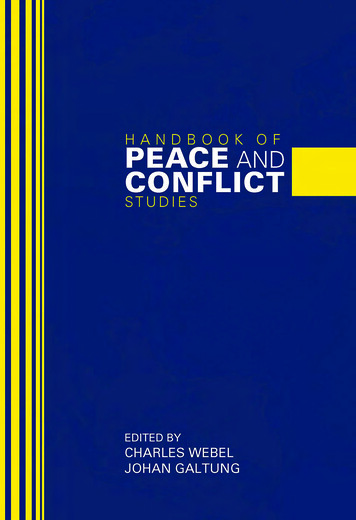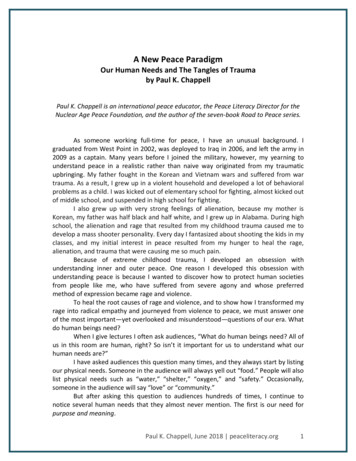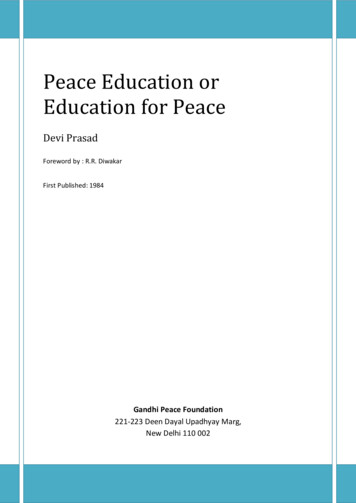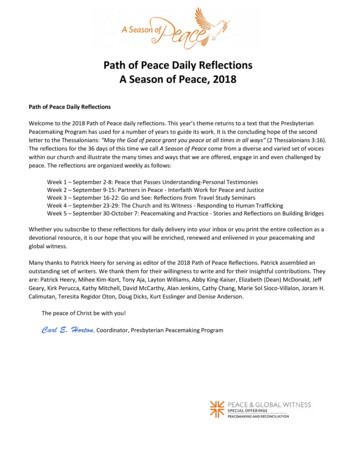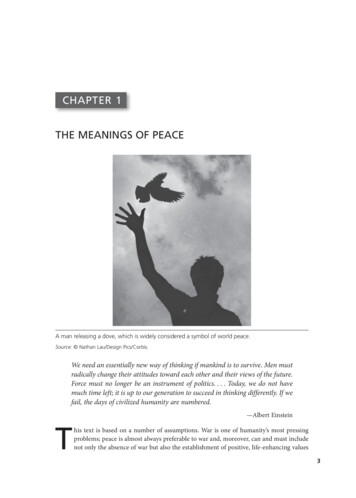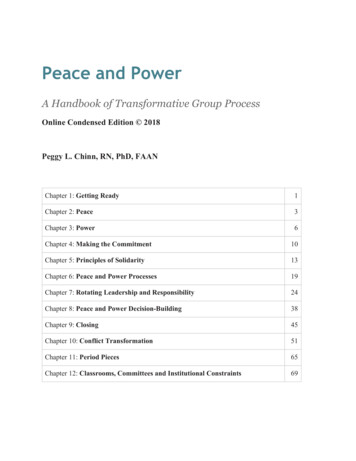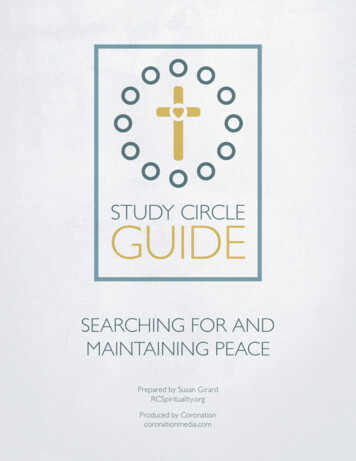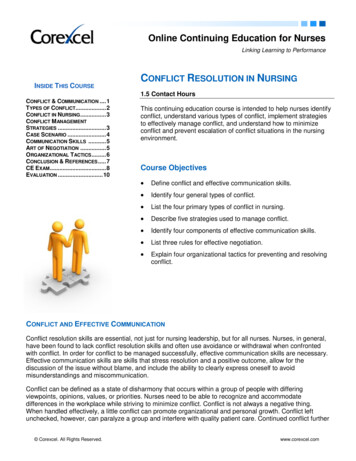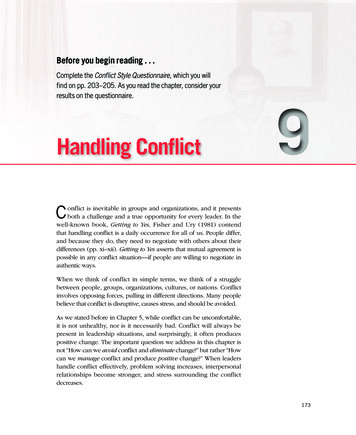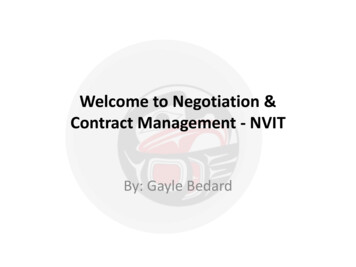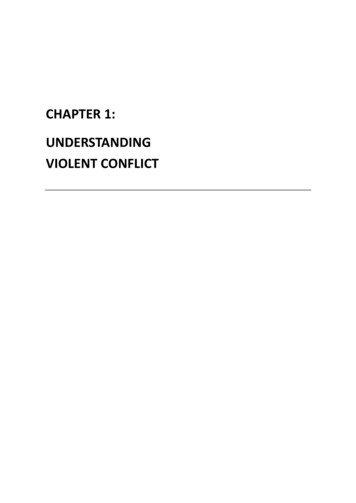
Transcription
Peace and Conflict
Peace and ConflictIntroductionOver 80 percent of all humanitarian crises are the result of conflict. Conflict is an intrinsic andinevitable aspect of social change, but how we deal with this conflict determines the impacts andoutcomes of change. Understanding how conflict can be managed, utilized, and transformedcan help promote more peaceful resolutions and responses. But what is peace and how is itaccomplished?As peace is a hypothetical construct, it is often easiest to define what peace is not—that is,conflict. Conflict is, from the Latin, “to clash or engage in a fight,” and occurs when two ormore individuals or groups pursue mutually incompatible goals. In fact, peace and conflict cantake different forms, occurring on a number of levels with a wide variety of causes and outcomes.Peace and conflict occur in various contexts, from the personal, family, school, and communitylevels to the international level. Peace and conflict studies often involve an exploration of theinterconnections among such issues as poverty, violence and non-violence, individual andoverall security, hunger, discrimination, human rights, war and justice, freedom, and the humancommunity. The interdisciplinary nature of peace and conflict studies means that teachers havelots of options in deciding what to teach and many opportunities to link their lessons with othertopics or areas of inquiry.BG-9.3
Peace and ConflictExploring the Issues1. Understanding Concepts of Peace and ConflictJohan Galtung, one of the founders in the field of peace and conflictstudies, proposed interrelated models of conflict, violence, and peace.Conflict is viewed as a dynamic process in which structure, attitudes, andbehaviour are constantly changing and influencing one another. Direct violence is ended by changingconflict behaviour, structural violence is ended by removing structural contradictions and injustices,and cultural violence is ended by changing attitudes. These relate in turn to broader strategies ofpeacekeeping, peace building, and peacemaking.Galtung defined negative peace as the absence of direct violence and positive peace as the absence of allthree forms of violence (direct, structural, and cultural).Galtung’s Models of Conflict, Violence, and PeaceConflictViolencePeaceContradictionStructural violencePeacebuildingAttitudeBehaviourCultural violence Direct violencePeacemakingPeacekeeping2. Preventing, Managing, and Resolving ConflictIt is important to remember that conflict is an inherent part of the human condition but thatviolent conflict can be prevented. There are a number of definitions and types of violence fromthe interpersonal to the global level (e.g., family violence, youth and gang violence, violence in theworkplace, hate crimes, and war). Understanding the nature of violence may include discussion ofsocial oppression, discrimination, and marginalization. Managing and resolving or transformingconflict can prevent the occurrence of violence.There are many aspects to conflict escalation and de-escalation. Lessons may include the following: Stages of conflict (e.g., difference to reconciliation) Strategic responses and skills and processes used in response (e.g., problem solving, preventativepeacekeeping, decentralization of power, etc.)BG-9.4
Peace and Conflict Approaches to conflict (e.g., withdrawal, compromise, yielding, etc.) The differences among positions, interests, and needs (interests are often easier to resolve thanpositions) Third-party intervention (coercive versus non-coercive forms) Different forms of power Symmetrical versus asymmetrical conflicts (see Glossary section) Non-violent forms of resistance Contemporary and Indigenous systems for resolving conflict and peace building3. Branches of Peace and Conflict StudiesTeachers may wish to focus in on one of the many branches of peace and conflict studies. Some ofthese include the following: Culture, peace, and conflict (e.g., the impact of cultural norms and world views on approaches toconflict management, ways in which cultural difference can become a source of conflict as well asa resource for peacemaking, for culturally sensitive approaches to conflict-resolution training andsocial change, and for localizing peace, etc.) Ethics of conflict resolution (e.g., ethics of conflict intervention) Gender, peace building, and conflict (e.g., the impact of conflict on women and children, the roleof women in peace building, UN Resolution 1325, etc.) International peace and conflict (e.g., causes of conflict and approaches for peace) Media, peace, and conflict Peace education (e.g., how to promote peace in the classroom, how educators can serve as rolemodels, etc.)BG-9.5
Peace and ConflictEssential QuestionsInquiry questions related to peace and conflict issues mayinclude the following: What elements should be present/absent in order for peace tooccur? Are there different kinds of peace? Can you describe them? What effect does inner peace have on external circumstances? How does peace relate to conflict? Is conflict always negative? Can you think of an instance where conflictmight be positive? What is the media’s role in promoting war? Aside from the individuals/groups in conflict, who else is affected by conflict (e.g., innocentcivilians in national armed conflicts, children in parental conflicts, etc.)? How are they affected(e.g., emotionally, physically, intellectually, etc.)? How do people of different ages or gender experience and/or deal with conflict differently? Should conflict resolution be different in different cultures? What are the current conflicts in your school? .community? .country? .other countries? Whatare some ways these could be resolved/transformed? What are sustainable forms of peace? How can they be achieved? Who needs to be involved? It is estimated that 22 of the 34 countries furthest away from achieving the United Nation’sMillennium Development Goals are affected by current or recent conflicts (United NationsDevelopment Programme). Of the 20 poorest countries, 16 have recently experienced civil war,resulting in severe hunger and poverty. Why do you think this is? How does development relateto conflict? How does this help us understand current conflicts? What might this suggest aboutpeace? Youth have an important role to play in peace and conflict. In contemporary armed conflicts,youth are often on the frontlines of combat and, after peace accords are signed, they are bothpotential threats to peace and significant peace-building resources (Carey, 2007). Why do youthhave such an impact on peace and conflict? What do you see as youth’s role in conflict and peace?BG-9.6
DYk?Peace and ConflictDid You Know?“90 percent of modern war casualties arecivilians—primarily women and children.”– Save the Children (CTP)“Armed conflict has declined by more than 40percent since 1992.”“The first bomb that the Allies dropped onBerlin during the Second World War killed theonly elephant at the Berlin Zoo.”– Amazing Facts.com (CTP)– Washington Post (CTP)“Conflicts have produced 31 million refugeesand other displaced persons, most of themwomen and children.”– Rotary International (CTP)“War has killed 2 million children in the last 20years.”“There are 92 known cases of nuclear bombslost at sea.”– Did You Know? (CTP)“Since 1495, there has never been a 25-yearperiod of time without war eruptingsomewhere in the world.”– Bluworld– Peace Pledge Union (CTP)“In the last 5,600 years, there have been only292 years of peace.”– Peace Pledge Union (CTP)“The longest war was called the Hundred YearsWar, where Britain and France battled for 116years, ending in 1453. Britain introduced directtaxation on the income of its citizens becauseof the high military expense. “– Bluworld“By the age of 16, the average American childhas witnessed 18,000 murders on television.”– New Internationalist (CTP)“On average, more Americans die each yearfrom lightning strikes than die as a result of aterrorist attack.”– Harper s Magazine (CTP)“The shortest war took place in 1896, whenZanzibar surrendered to Britain after 38minutes.”– Bluworld“With the combined causalities of the Firstand Second World Wars, the Vietnam War, andthe Korean War, as well as an increase of civiland region conflicts, the 20th century was thebloodiest century in history.”– BluworldBG-9.7
DYk?Peace and Conflict“In today’s armed conflicts, more than 90 percentof deaths are civilians and half of them arechildren. Less than 10 percent of casualties fromarmed conflicts are soldiers.”– Bluworld“1994, the Rwanda genocide killed over half amillion people, including about three-quartersof the Tutsi population. The UN Security Councilassisted the International Criminal Tribunal forRwanda, which charged at least 10,000 peoplewith human rights violations and crimes againsthumanity.”“Violent conflict has also caused some of theworld’s worst environmental disasters. Forexample, the United States sprayed 77 millionlitres of toxic Agent Orange in Vietnam, and 36tonnes of depleted uranium from armour-piercingbullets was left behind in Kuwait and Iraq after theGulf War.”– Bluworld– Bluworld“In 1994, the World Health Organization declaredviolence as the ‘leading worldwide public healthproblem.’”“Landmines still cover large areas of at least 90 ofthe world’s countries. About 25,000 people areinjured or killed by landmines each year, primarilyin Iraq, Afghanistan, Cambodia, Angola, and Africa.Africa alone has between 18–30 million landmines.Not only do these landmines endanger human life,but they also make land unusable in countries thatalready lack resources.”– Bluworld– Bluworld“The UN has been the most successful peacepreserving and mediation institution, even thoughits budget is only a small fraction (approximately1.8 percent) of global military spending.”“Not only is global military spending 170 timesgreater than global spending on education, butthe lowest literacy rates and access to educationare in areas of continued war and conflict.”– Bluworld– Bluworld“Ninety percent of human death due to conflict iscaused by small arms like handguns, sub-machineguns, landmines, and grenades.”– Bluworld“Some 639 million guns make up the globalstockpile of small arms—60 percent of thembelong to civilians. Estimates of the black markettrade of small arms reach up to 10 billion a year.”– Bluworld“Though over 300 international conflicts brokeout between 1945 and 2000, there were also3,750 cases of mediation within those same years.Institutional mediation resolved 255 worldwideconflicts from 1945 to 1974.”– Bluworld“Civil wars in El Salvador, Mozambique, Namibia,Nicaragua, and South Africa were all broughtto an end through civil negotiation and formalmediation.”BG-9.8– Bluworld
DYk?Peace and ConflictEffective Examples of Non-violence in History: The British gave up their occupation of India after a decades-long non-violent struggle led byGandhi. The Nazis were resisted effectively by Danes and other occupied peoples of Europe in the SecondWorld War. African-Americans opted for non-violent action to defeat segregation in the United States in the1960s. The Polish Solidarity movement used strikes to win the right to organize freely, a historic first incommunist Poland. Filipinos and Chileans brought down dictators in the 1980s through non-violent action. The non-violent civic movement in South Africa employed boycotts and other sanctions to weakenthe Apartheid regime to the point of forcing negotiations on the country’s political future. East Europeans and Mongolians organized mass non-violent campaigns to topple their communistgovernments. The Serbs ousted Slobodan Milosevic in 2000 after a non-violent student movement helped co-optthe police and military and undermine his base of support.People who work in the field of peace and conflict have careers in education, journalism, courts,government, foreign services, international development, non-governmental organizations, andcorporations that invest overseas.BG-9.9
Peace and ConflictThought-Provoking Quotations”Non-violence is not inaction. It is notdiscussion. It is not for the timid or weak.Non-violence is hard work. It is thewillingness to sacrifice. It is the patience to win.”– Cesar Chavez“Unless we teach children peace, someone else will teach them violence.”– Colman McCarthy“Peace, in the sense of the absence of war, is of little value to someone who is dying of hungeror cold. It will not remove the pain of torture inflicted on a prisoner of conscience. It does notcomfort those who have lost their loved ones in floods caused by senseless deforestation in aneighbouring country. Peace can only last where human rights are respected, where peopleare fed, and where individuals and nations are free.”– 14th Dalai Lama (1995)“Each person has inside a basic decency and goodness. If he listens to it and acts on it, heis giving a great deal of what it is the world needs most. It is not complicated but it takescourage. It takes courage for a person to listen to his own goodness and act on it.”– Pablo Casals“United we stand, divided we fall.”– Aesop“Toleration is good for all, or it is good for none.”– Edmund Burke“If we could change ourselves, the tendencies in the world would also change.”– Mohandas GandhiBG-9.10
Peace and Conflict“The purpose of all war is peace.”– St. Augustine“In the practice of tolerance, one’s enemy is the best teacher.”– 14th Dalai Lama (2006)“A human being is a part of the whole that we call the universe, a part limited in time and space.He experiences himself, his thoughts and feelings, as something separated from the rest—a kindof optical illusion of his consciousness. This illusion is a prison for us, restricting us to our personaldesires and to affection for only the few people nearest us. Our task must be to free ourselvesfrom this prison by widening our circle of compassion to embrace all living beings and all ofnature.”– Albert Einstein“War is no solution to a problem. It’s useless. Why make things that destroy humanity?”– Charles Mance“We may have all come on different ships, but we’re in the same boat now.”– Martin Luther King, Jr.“What you do not want others to do to you, do not do to others.”– Confucius (Tu, et al.)BG-9.11
Peace and ConflictMaking a DifferenceNameCesar ChavezDavidMcTaggartDr. MartinLuther King JrGene SharpHenry DunantJohan GultangMalalaYousafzaiMohandasKaramchandGandhiHow they make a differenceCesar Chavez, a Mexican-American, became the best known Latino Americancivil rights activist. He is known for his non-violent tactics, which made the farmworkers’ struggle a moral cause with wide support.David McTaggart (Canadian), an environmentalist who played a central part inthe foundation of Greenpeace International, protested the testing of nuclearweapons by the French Government and led a campaign to create the SouthernOcean Whale Sanctuary.Dr. Martin Luther King Jr., leader of the African-American civil rights movement,was particularly famous for his “I Have a Dream” speech. King was awarded theNobel Peace Prize in 1964 for combating racial inequality through non-violence.Gene Sharp, known for his extensive writings on non-violent struggle, influencednumerous anti-government resistance movements around the world. GeneSharp was nominated for the Nobel Peace Prize in 2015 and was previouslynominated three times in 2009, 2012, and 2013.Henry Dunant, a 19th-century Swiss businessman, proposed that volunteer reliefgroups be granted protection during war in order to care for the wounded. Thiswas in response to witnessing the aftermath of a bloody battle between Frenchand Austrian armies in Solferino, Italy, in which thousands of wounded men wereleft to die on the battlefield. Based on Dunant’s suggestions, the InternationalCommittee of the Red Cross formed in Geneva, and began the development ofthe Geneva Conventions, providing protection for people in times of conflict.Johan Gultang, a Norwegian sociologist, mathematician, and the principalfounder of the discipline of peace and conflict studies, developed severalinfluential theories, such as the distinction between positive and negative peace,structural violence, theories on conflict and conflict resolution, and the conceptof peace building.Malala Yousafzai, a Pakistani advocate for female education, was shot in the headfor attending school. She is now the youngest recipient of the Nobel Peace Prize(at age 17) and was named one of “The 100 Most Influential People in the World”in 2013 by Time Magazine.Mohandas Karamchand Gandhi led India to independence by employing nonviolent civil disobedience tactics. Gandhi inspired movements for civil rightsand freedom across the world. The title “Mahatma” Ghandi, is Sanskrit for “highsouled” or “venerable” and was first applied to him in 1914 in South Africa.BG-9.12
Peace and ConflictGlossaryArmed conflict:“Conflicts where parties on both sidesresort to the use of force. (Ramsbotham etal., p. 28)Mediation:A voluntary process, involving theintervention of a third party.Negative peace:Asymmetric conflict:“When conflict arises between dissimilarparties, such as between a majority and aminority, an established government anda group of rebels, a master and his servant,or an employer and her employees. Theseconflicts lie not in particular issues orinterests but in the very structure of whothey are and the relationship betweenthem.” (Ramsbotham et al., p. 24)Conflict:“The pursuit of incompatible goals bydifferent groups.” (Ramsbotham et al., p.27)Conflict resolution:Where the deep-rooted source of conflictare addressed and transformed. The termis used to refer both to the process (orintention) to bring about changes and tothe completion of the process. The aim ofconflict resolution is not the eliminationof conflict but rather to transform actuallyor potentially violent conflict into peaceful(non-violent) processes of social andpolitical change. (Ramsbotham et al., p0.29)BG-9.13“The absence of violence.” (Knox)Negotiation:“The process whereby the parties withinthe conflict seek to settle or resolve theirdifferences.” (Ramsbotham et al., p. 29)Peace building:An underpinning of the work ofpeacemaking and peacekeeping that isaccomplished by addressing structuralissues and the long-term relationshipsbetween conflictants.Peacekeeping:Refers to the interposition of internationalarmed forces to separate the armed forcesof belligerents. (Ramsbotham et al., p. 32)Peacemaking:“The sense of moving towards settlementof armed conflict, where parties inconflict are induced to reach agreementvoluntarily.” (Ramsbotham et al., p. 32)Positive peace:“The presence of social justice andequality, and the absence of structural orindirect violence;” not only the absence ofwar but also absence of the instrumentsand the institutions of war. (Knox)
PeaceandConflictConflictPeace andReconciliation:Violent or deadly conflict:“A longer term process of overcominghostility and mistrust between dividedpeoples.” (Ramsbotham et al., p. 32)“Similar to armed conflict but alsoincludes one-sided, direct, physical violencesuch as genocides against unarmedcivilians.” (Ramsbotham et al., p. 31)Restorative justice:Restorative justice involves activeparticipation to work towards a peacefulresolution by those involved in a dispute orthose responsible for or affected by a crime.Symmetrical conflict:“Conflicts of interest between relativelysimilar parties such as a brother and sister,an employee and another employee, or twoestablished governments.” (Ramsbotham etal., p. 24)BG-9.14
Peace and ConflictResourcesBooksMiller, Christopher E. A Glossary of Terms and Concepts in Peace and Conflict Studies,2nd Edition. Ed. Mary E. King. San José, Costa Rica: University for Peace, 2005.Available online at www.upeace.org/pdf/glossaryv2.pdfPeaceJam. Ambassadors Curriculum, Ages 14–19. Arvada, CO: PeaceJam Foundation, 2014.Available online at www.peacejam.org/media/1070/ambassadors sample.pdfSharp, Gene. The Politics of Nonviolent Action (3 Vols.). Brooklyn, NY: Porter Sargent,1973.UNESCO. From a Culture of Violence to a Culture of Peace. Paris, France: UNESCO, 1996.Available online at 9e.pdfUnited States Institute of Peace. Peace Terms: Glossary of Terms for Conflict Managementand Peacebuilding. Ed. Dan Snodderly. Washington, DC: Academy for InternationalConflict Management and Peacebuilding, and United States Institute of Peace, 2011.Available online at ceterms.pdfRamsbotham, Oliver, Hugh Miall, and Tom Woodhouse. Contemporary ConflictResolution. Cambridge, UK: Polity, 2011.JournalsUniversity for Peace. Africa Peace and Conflict Journal. 2014. www.africa-upeace.org/index.php?option com content&view article&id 76&Itemid 109 (dateaccessed—2017-05-25).SAGE Journals. Conflict Management and Peace Science. 2016. http://journals.sagepub.com/home/cmp (date accessed—2017-05-25).Villanova University Center for Peace and Justice Education. Journal for Peace and JusticeStudies. 2017. djustice/journal.html (date accessed—2017-05-25).SAGE Journals. Journal of Conflict Resolution. 2017. http://journals.sagepub.com/home/jcr(date accessed—2017-05-25).University of San Francisco. Peace Review: A Journal of Social Justice. 2017. -review-journal (date accessed—2017-05-25).BG-9.15
PeaceandConflictConflictPeace andWebsitesCeeds of Peace. “More Peace Resources.” Ceeds of Peace. 2017. https://www.ceedsofpeace.org/category/resources/ (date accessed—2017-05-25).Morris, Catherine. Conflict Transformation and Peacebuilding: A Selected Bibliography.2008. tml (dateaccessed—2017-05-25).Teachers without Borders. Peace Education Course. 2017. http://teacherswithoutborders.org/peacecourse/ (date accessed—2017-05-25).United States Institute of Peace. Public Education. “For Educators.” n.d. m source buildingpeace.org&utmcontent educators (date accessed—2017-05-25).More resources can be found at http://mediationserviceswpg.ca/resources/BG-9.16
Peace and ConflictReferencesAesop. “The Four Oxen and the Lion.” Aesop’s Fables. 2007. andtheLion (date accessed 2017-05-24).BluWorld. “Conflict Resolution: Did You Know?” Learning Center. n.d. ution/did-you-know/ (date accessed—2017-05-24).Burke, Edmund. The Works of Edmund Burke: With a Memoir, in Three Volumes, Volume2. New York, NY: Harper, 1837. 450.Carey, Henry F. “Troublemakers or Peacemakers? Youth and Post-Accord Peace Building bySiobhan McEvoy-Levy.” Political Science Quarterly, 122: 355 –357.Casals, Pablo. Everyday Enlightenment: The Essential Guide to Finding Happiness in theModern World. Ed. Gyalwang Drukpa. New York, NY: Penguin Books Ltd., Mar 15,2012.Changing the Present (CTP). Peace Facts. 2014–2017. www.changingthepresent.org/peace/facts (date accessed—2017-05-24).Chavez, Cesar. An Organizer’s Tale: Speeches. Ed. Ilan Stavans. New York, NY: PenguinBooks Ltd., 2008.Dalai Lama XIV Bstan-’dzin-rgya-mtsho. Kindness, Clarity, and Insight. Ed. JeffreyHopkins. New Delhi, India: Motilal Banarsidass Publishers, 2006. 12. The Spirit of Tibet, Universal Heritage: Selected Speeches and Writings of HH the DalaiLama XIV. Mumbai, Maharashtra: Allied Publishers, 1995.Einstein, Albert. The Enlightened Mind: An Anthology of Sacred Prose. Ed. StephenMitchell. New York, NY: Harper Collins, 1991. 191.Gandhi, Mohandas. Inspire Wisdom: A Collection of Inspirational Messages. Ed. PeroniaScott Canidate. Wheaton, IL: Xlibris, Inc., 2014. 81.King, Martin Luther Jr. “We May Have All Come on Different Ships, But We’re in theSame Boat Now.” Human Rights Campaign. January 19, 2004. l-come-on-different-ships-but-were-in-the (dateaccessed—2017-05-24).Mance, Charles. A Fairer World. “Peace & Conflict.” n.d. http://afairerworld.org/peace/(date accessed—2017-05-24).McCarthy, Colman. “Quotes.” Do One Thing: Be a Hero for a Better World. n.d. htm (date accessed 2017-05-24).BG-9.17
PeaceandConflictConflictPeace andRamsbotham, Oliver, Hugh Miall, and Tom Woodhouse. Contemporary ConflictResolution. Cambridge, UK: Polity, 2011.St. Augustine. Diplomat’s Dictionary. Ed. Charles W. Freeman Jr. Institute for NationalStrategic Studies. Washington, DC: National Defense University Press, 2014.276.Tu, Weiming, and Ikeda Daisaku. New Horizons in Eastern Humanism: Buddhism,Confucianism and the Quest for Global Peace. New York City, NY: I.B. Tauris,2011. 56.BG-9.18
– Harper s Magazine (CTP) “The first bomb that the Allies dropped on Berlin during the Second World War killed the only elephant at the Berlin Zoo.” – Amazing Facts.com (CTP) “There are 92 known cases of nuclear bombs lost at sea.” – Did You Know? (CTP) “Since 1495, there has
